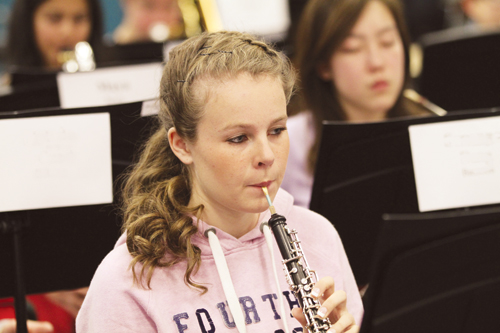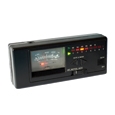
At some point, every oboist and director has endured a dreadfully uncomfortable tuning experience. The oboist gives the A and sees the electronic tuner jump wildly from one extreme to another. The pitch is unstable. Reacting to the wildly fluctuating response on the tuner, the oboist wrestles with the pitch to make it point at zero, first overshooting the pitch and then overcompensating in the other direction. As this happens the other members of the ensemble begin to crane their necks toward the oboist, leading to whispers and gossip after rehearsal about the terrible tuning note. An experience like this may cause even the more polite players in the ensemble to become unsure of when to join the tuning note. A poor tuning note can rattle the confidence of the entire ensemble, setting a negative tone for the entire rehearsal or concert.
Experiences like these can make both oboists and directors apprehensive about tuning. Directors who find the process too stressful and difficult may opt for another approach, such as relying on a strobe tuner or using another instrument to initiate tuning. While these alternatives may have some advantages, particularly for less experienced ensembles, it is important to work with oboists on the tuning process at every level. At some point, all oboists will be called upon to give the tuning pitch, and they should be well prepared to do so. The sooner oboists become familiar with the process, the more time they will have to develop this essential skill.
Guiding oboists through the tuning process and providing good tips on how to tune the ensemble will serve the greater goal of improving the confidence and playing quality of the ensemble. The right guidance will also help reduce the stress and anxiety that oboists too often feel when it is time for tuning.
How the Professionals Start
An established routine that begins early will give the oboe player a chance to warm up a bit first, which helps to limit any anxiety and create a situation for success. In professional ensembles, oboists are typically the first musicians to arrive at rehearsals and concerts. An early arrival allows the oboists to check their reeds, warm up, and establish a pitch center for the ensemble as more musicians arrive and warm up, joining the pitch center that has already been established. By the time the actual rehearsal or concert begins, the tuning A serves mostly as a final check that allows for small adjustments. The ensemble members have already tuned themselves by listening and joining the warm-up routines in progress. Although this sort of warm-up process, which usually lasts about twenty minutes, is generally not practical in most school settings or for less experienced musicians, some of the same strategies (starting early and developing good ensemble listening) can be used by student musicians and can lead to more consistent intonation for a school ensemble.
Tuning Equipment
One of the first purchases every oboist should make is a high-quality tuner. The tuner should be able to produce a chromatic scale of reference tones, and it should have a needle with adjustable sensitivity. Many oboists prefer to use a tuner that includes a clip-on microphone, attachable to the bell of the oboe, which will make the needle respond faster. Oboists who are using the built-in microphone should wait a bit for the needle to adjust, because the needle takes longer to register the sound. Sometimes the quality of articulation will affect how the sound is initially picked up, and this is another reason to wait a moment. There are also several good tuning apps and strobe-style tuners available for smart phones. Although a good-quality tuning app is sufficient, it might not be appropriate for school rehearsals or for the concert stage. (Even in silent mode and when used only for the tuning feature, a smart phone is still a distraction, and there is also the risk that it could unexpectedly make a sound during performance.) Once students have a good tuner to work with, they should be taught effective ways to use it to help refine listening skills and memory.
Practice
An oboist’s work on tuning should include frequent practice at home. Ask your oboists how they practice giving the tuning note, and encourage them to make work on tuning a part of their daily practice routine. During a single practice session, an oboist should practice giving the tuning note several times, on multiple reeds. As they do this, oboists likely will find that their pitch tendencies vary during the session and from one reed to the next. Similar to what happens with most large ensembles, the pitch of most oboists will rise as the practice session goes on. Oboists typically want their sound to sing and to cut through the ensemble, and this preference for brightness often leads to sharpness in pitch. To counter this tendency, throughout the practice session oboists should recalibrate their ears back to A=440 through the use of a drone pitch. In addition to practicing the tuning note, oboists should practice scales and technical patterns while using a drone or reference pitch.
Good Habits, Practical Tips, and Some Advice on Equipment
In advance of any rehearsal or concert, oboists should decide which reeds they plan to use, ranking their top three reeds. The feel and tone of a reed can vary substantially, and fluctuations in humidity and atmospheric pressure can quickly change a reed. By having the top three reeds identified before each rehearsal and concert, oboists can feel more settled and ready to give the tuning note more quickly. If oboists are making their own reeds, they should be discouraged from doing any significant reed work during rehearsals. Sometimes a reed might require an emergency adjustment, but as a general rule, this should be done very rarely in the rehearsal setting. Oboists should develop a habit of preparing reeds well and then playing on their reed choice with minimal fiddling once the rehearsal has begun.
The best way for an oboist to develop consistency in internalizing the pitch center is to work on matching a drone pitch instead of working with the needle on a tuner. To give a good tuning pitch, oboists first must hear the note in their minds; after they have done that, they can then confirm that they are hearing the correct pitch by referring to the needle of the tuner as they play. Before any tuning note is given, the oboist should first listen to the reference tone on the tuner. This step can be done while the other players are still setting up, so it will not add any time to the tuning process. Just as the rest of the ensemble gets their reference pitch from listening to the oboe and the rest of the ensemble, it is equally important that the oboist receives a reference pitch from the tuner before the tuning note is given. If the oboist uses a reference pitch and then uses the tuning needle to confirm that pitch, it is less likely that the tuning pitch will be completely wild. If the oboist struggles with internalizing the pitch, you can suggest that the oboist try singing it first. It should be noted, however, that the mechanics of singing and oboe playing are quite different, so this exercise is not an ideal solution, and thus it is necessary for oboists to learn how to hear the pitch consistently in their heads.
The French style of oboe played throughout the United States is constructed to be played at A=440. With intermediate-level oboes in particular, it is difficult to play any higher than A=440 if appropriate embouchure and air flow are used. Keyboard percussion instruments typically are tuned at A=442, because they are fixed pitch. This higher pitch allows the keyboard percussion to not sound flat when the rest of the ensemble migrates a bit sharp in rehearsal or concert, which often occurs. Despite the typical tuning of keyboard percussion, it is important to tune the ensemble at A=440 and not to allow the pitch to be established too high initially. When players have a prominent line with the keyboard percussion, they will naturally make an adjustment to match that instrument. If the initial tuning were to begin at A=442, the players would have to work too hard to keep the pitch up, and the pitch would migrate even higher than it normally would.
On oboe, pitch stability begins with the oboe reed. Oboe intonation is determined by the relationship between the reed, the air flow, and the embouchure. The oboe embouchure must be flexible so that the player can remain in tune throughout the range of the instrument. Because of the conical shape of the instrument and the vibration of the double reed, oboe players must have less reed in the mouth for lower notes and more reed in the mouth for higher notes. The key to playing in tune is to be able to navigate the reed fluidly in and out of the mouth, according to the range. If a reed is very flat in pitch, it will lack stability, and the player will bite the reed to try to gain control.
When tuning is unstable, directors should check the stability of the reed. Ask the oboe player to crow the reed, placing the entire cane part of the reed in their mouth, and blowing strongly. Ideally the reed will crow a C in two octaves. If the reed has a more complex crow, similar to the multiple pitches present in the crow of a bassoon reed, then it lacks stability. Likewise, if the reed is significantly lower in pitch than a C, it will lack stability as well.
Oboists at every level should play on hand-made reeds. The process used with mass-produced reeds tends to remove too much cane, which depletes the reed of its internal structure, and as a result, mass-produced reeds are often extremely flat and wild. As players try to make these reeds play in tune, they will tend to put too much pressure on the reed to compensate. The unfortunate result with these reeds is not only a higher pitch overall, but also intonation that cannot be maintained throughout the range of the instrument.
Hand-made reeds are readily available online through double reed specialty stores. Because there are fewer oboe players in comparison with other instruments, most local music stores do not carry hand-made reeds. Double reed specialty stores on the internet are a wonderful resource to oboists at all levels. A hand-made reed has an infrastructure carved into it, which allows for clear articulation and serves as a container for the air. Oboists can freely blow through a hand-made reed without the worry of the tone spreading or a wild and unrefined sound. Even with good hand-made reeds, there is still a significant range on which oboists can place any given pitch, which is why ear training remains an important element for oboists at all levels.
The oboe reed should be fully inserted into the reed well at the top of the instrument at all times. Oboists should never be asked to pull out or push in their reeds. It is also important that there is no gap between the staple or tube of the oboe reed and the reed well. Sometimes the cork that covers the metal tube may be too thick to fit within the reed well. If that is the case, first try cork grease on the reed. If that does not allow the reed to fit easily, use a file or an emery board to remove some of the cork uniformly.
Tuning on the oboe depends on the relationship between embouchure and air flow. This is why pulling the reed out of the instrument will have little effect on intonation. However, pulling the reed out, even a little bit, will severely degrade the tone quality of the instrument. This impact on tone quality varies throughout the range of the instrument, but it is particularly obvious on the C in the middle of the oboe’s range. This adjustment makes a very open and thin sounding note even more unstable. Oboists will try to cover the instability with more embouchure pressure, and the pitch will get even sharper and the tone more thin. If the oboe is playing consistently sharp, first check that the reed is not flat. When reeds are flat oboists tend to overcompensate by using too much embouchure pressure, which causes the pitch to go sharp. If the reed is not flat, ask them to pull the reed out of their mouth. Less reed in the mouth, along with a more flexible embouchure, will fix most sharpness.
Ensemble Etiquette
It is not appropriate for other ensemble members to look at the principal oboist’s tuner. Sometimes other players, particularly the second oboe player, may be tempted to look to see how the tuning note registers. Other players should make a concerted effort to divert their eyes from the tuner. It is distracting and can be stressful when others move around to look at the needle.
Ideally, when the oboist sounds the tuning note, the rest of the ensemble will wait a moment to hear the settled pitch and then join the note. There is no need to wait many seconds before joining the sound. The rest of the ensemble should focus on matching the pitch with their ears rather than their eyes. Other oboists in the section should also wait until most of the ensemble has joined the tuning note, so that the additional oboe timbre does not distract or disorient the rest of the ensemble.
Additional Tuning Pitches
Often in band settings, the oboe player is asked to give a Bb tuning note following the A. One common tendency for oboists is to place the Bb too low, because they hear the A as a leading tone to Bb, and they tune to the true interval rather than to the equally tempered interval essential for tuning. There are two ways to address this situation. First, the oboist can get a reference pitch of Bb from the tuner, listen to the pitch, and then return to the needle setting, which will register the tuning note. This reference pitch can be played softly so that it will not be audible to the audience. Secondly, the oboist can think of the A as scale-degree two in a G-minor triad. Finding Bb from the tonic pitch of G will tend to make Bb seem higher than it would be relative to A, and the resulting Bb will tend to be more accurate.
Occasionally oboists are asked to give an F as well. This pitch tends to be even more problematic as a tuning note. First, because the lowest note on the oboe is a Bb, the F has many overtones. The timbre on the F is also much stronger than it is with other notes. To counter these difficulties, oboists are often tempted to give the tuning note with the forked F fingering, rather than the regular F fingering because this will mute the tone a bit. However, oboists should be encouraged to play using the regular F fingering whenever possible. The forked F tends to have a muffled sound and usually sits flat in pitch. On most oboes, there is usually one very unstable note between E5 and G5, and on many oboes, the unstable note is the F. The lower octave F is not a better choice, because it can be more difficult to articulate, particularly if the instrument is even slightly out of adjustment. If directors find the F essential to the tuning sequence for some instruments, one solution may be to have those instruments play the F when a second Bb tuning note is given, and then they can tune intervallically.
Developing a consistent tuning ritual and teaching key tips to the oboist, such as how to find a good quality reed and how to practice internalizing tuning pitches, are important tasks for any director. The right advice and habits can improve the tuning process that starts off the ensemble’s work, which can go a long way toward achieving greater ensemble intonation and confidence.






